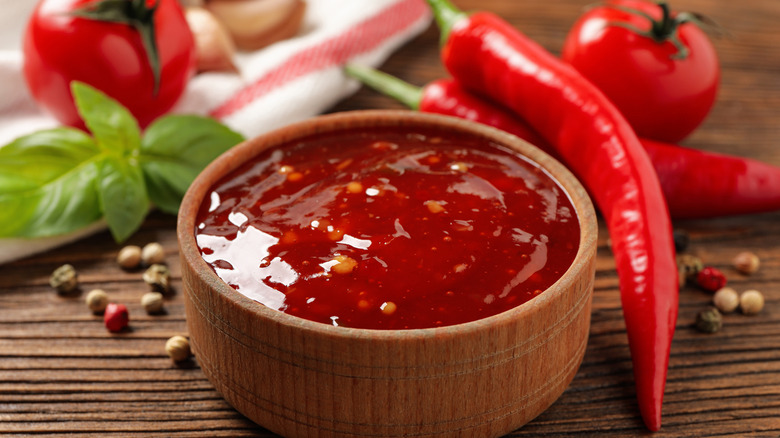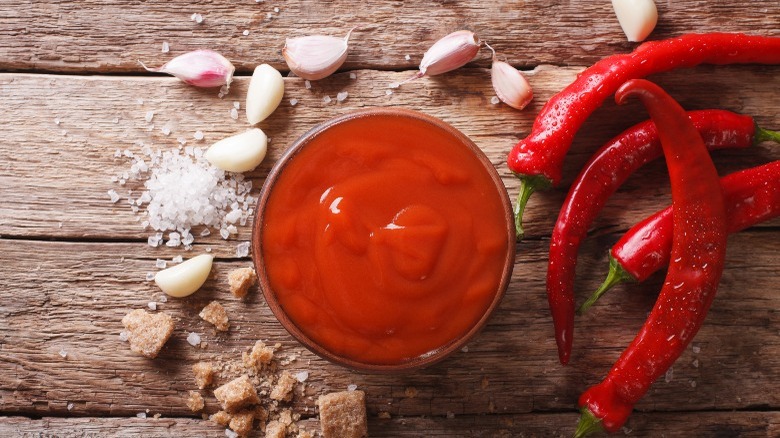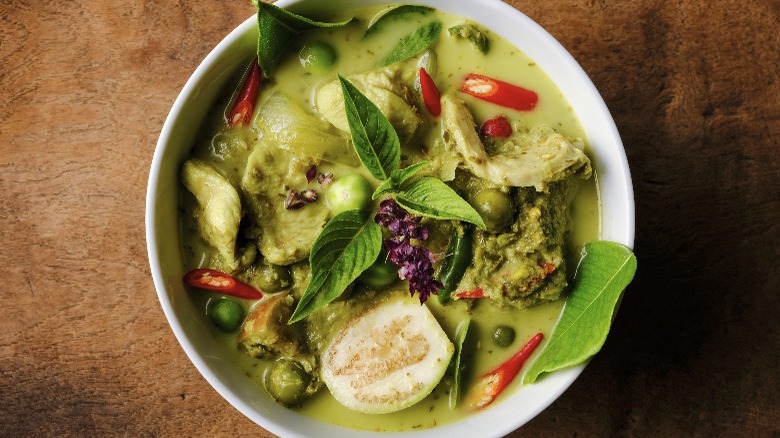What Is Thai 'Klom Klom' And How Do You Cook With It?
The complex, aromatic flavor palettes of Thai food are a reflection of its home country's location at the crossroads of Southeast Asia. Influenced by India, China, and the neighboring cultures of Laos, Myanmar, Malaysia, and Indonesia, Thai cuisine combines a diverse array of tastes in one highly unique melting pot. This mixture of spicy and sweet, of salty and sour, can be summed up in one succinct phrase: "klom klom."
Although the saying is sometimes translated to "tasty," "klom klom" is a lot more complicated than that. The bottles of sriracha that line supermarket shelves may offer a more specific description of what the term refers to, but therein lies a caveat — the Huy Fong rooster brand that is most commonly sold in mainstream stores doesn't actually offer the most accurate and authentic Thai flavor experience. To be fair, concocting a dish that matches the bold yet delicate combination of flavors requires a careful balance of ingredients that takes skill and practice to master.
The staple of sriracha
The most important aspect of "klom klom" — and the most difficult element to replicate in a recipe — is the lack of one single flavor standing out above the rest. As Australian Chef David Thompson told The Guardian, "It's about the juggling of disparate elements to create a harmonious finish." In the case of sriracha, a precise medley of garlic, chili peppers, vinegar, and sugar creates the ideal hot sauce.
According to Saowanit Trikityanukul, the granddaughter of sriracha inventor Thanom Chakkapak, the original batches of the sauce had to have the healthiest pickled garlic, the most "perfectly red" chilis, and salt strained from scratch — as in boiled out of "big chunks" of rock. In the NPR interview, Saowanit expressed that the Rooster brand isn't "mixed together properly." Americans may enjoy the hotness that a dab of sriracha enlivens a dish with, but the truth is that the sauce needs more than just spiciness. Talking to Thrillist, Quincy Surasmith of the Asian Americana podcast notes that "Thai varieties [of sriracha] are both spicier and less heat forward" and that the "flavor profile is more rounded with sugar and garlic, and just a bit of salt and vinegar." That means that it takes a delicate ratio for the ingredients in a sufficiently balanced sriracha sauce to balance out.
Creating klom klom
Just like a proper batch of sriracha, any other Thai dish should harmonize the five basic tastes. Indeed, the spiciness is only one part of the puzzle, and ingredients run the gamut from citrusy lemongrass to sweetly licorice-like Thai basil. Indian curry also influenced Thai cooking, though Thailand's unique stews are completely different, turning the powder into a paste while adding a host of herbs, roots, and veggies like galangal and bamboo. Likewise, stir-fried noodles are a Chinese contribution that has taken on a life of their own in Thai cuisine.
All of this variety makes it difficult to pinpoint how, exactly, to achieve "klom klom." Specifically, Thai ingredients are necessary, meaning that a trip to your local Southeast Asian market might be necessary. Fish sauce and shrimp paste add a savory base flavor that's more interesting and complex than mere saltiness, while kaffir lime and lemongrass provide a slightly spicy zest akin to ginger citrus. Coconut milk can help with the sweetness, and of course, chili peppers are also key. The world of Thai chilis can get a little dizzying, but cayenne and serrano can act as appropriate substitutes in a pinch. It'll take a fair amount of trial and error before the point of peak "klom klom," but with patience and discipline, the warm aromas of Thai cuisine will waft around your kitchen.



